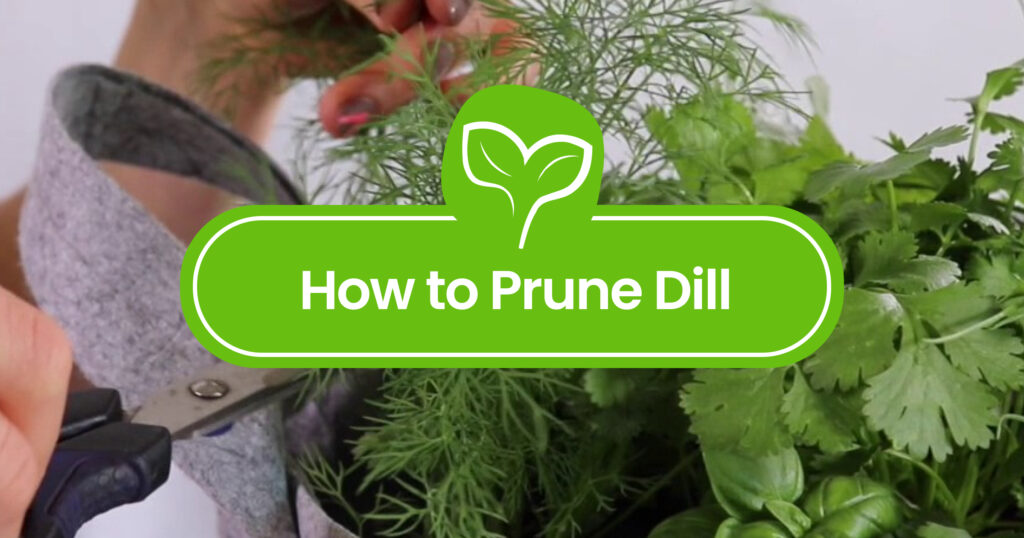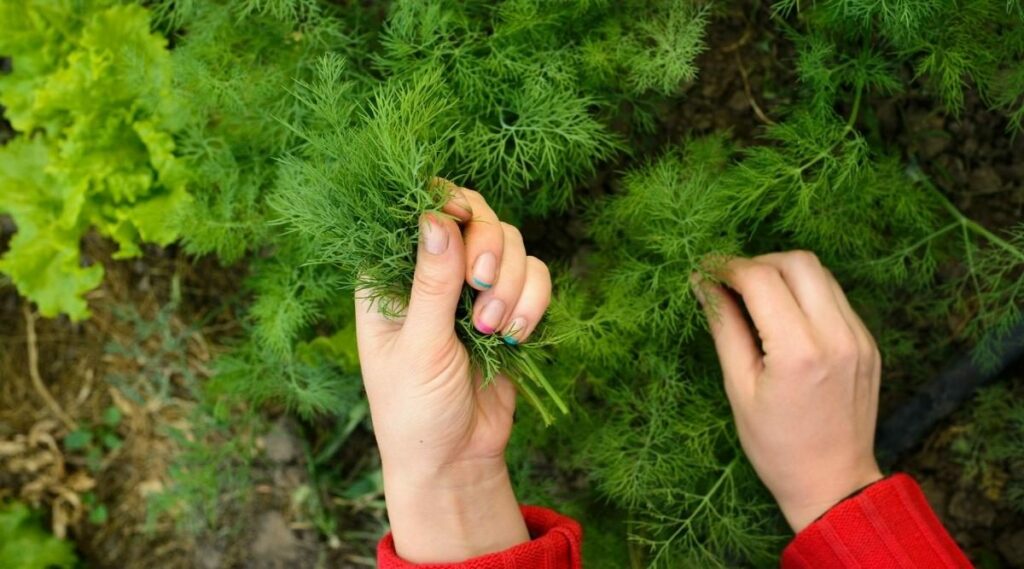
If you’ve ever grown herbs at home, you might be familiar with the importance of pruning. Dill is no different and benefits largely from regular pruning!
Read on to discover how to prune dill and how this simple practice benefits your herb’s flavor, aroma, and overall health
About Dill and its Pruning Basics
Dill, a herb that can grow up to 4 feet tall and produces pretty yellow flowers, is known for its distinct flavor. And thanks to its countless culinary uses, it’s appreciated in every kitchen. You can throw it in any dish, turn it into seasoning or make dill pickles – those are just a few options!
Dill is also incredibly simple to care for. A big part of caring for this herb is regular pruning. Not only helps pruning maintain the desired look of the herb, it also enhances its aroma and flavor.
How to Prune Dill – Techniques & Timing
If you’re new to gardening and growing your herbs, you might wonder what pruning is. Pruning is a practice of selectively removings parts of plants, such as leaves, branches, stems, and roots. It plays an essential role in promoting healthy growth.
Before you start pruning your dill, it’s good to understand the correct timing. The good news is, there is no set time to prune dill! Dill should be regularly pruned throughout its growing season. However, let your plants grow 8 inches tall before giving them their first trim – this generally happens around four weeks after planting.
There are two main methods for pruning dill – pinching and selective pruning.
Pinching
- You can pinch off leaves from your dill plant once it’s around 8 inches tall. You won’t need any tools for it – you do need to wash your hands!
- Use your thumb and forefinger to pinch off the leaves from the top part of the stem.
- Pinch off up to ⅓ of the plant.
- Repeat every couple of weeks.
Selective pruning
- Start by removing any dead or damaged leaves and stems (use a pair of pruning shears.).
- Trim back any leggy stems.
- Trim leaves and stems in overcrowded areas. Cut the stems close to the base stem.
- Prune the parts you want to remove to achieve your desired plant shape.
Most home gardeners want to pinch off flower buds as soon as they appear – this helps delay the plant seeding and extends its life. Allow the plant to flower if your goal is to collect the seeds.
Tools and equipment – what do you need?
All you need for pruning a dill plant is a pair of pruning shears or scissors – that’s it! While gardening gloves aren’t crucial, they help to protect your skin from rough stems and irritants. Whether you’re pruning dill, blueberries, or fiddle leaf, always sterilize your tools before use!
How does pruning affect the flavor and health of dill?

Pruning comes with benefits for the overall health of dill plants. As the process promotes lateral branching, it results in bushy plants and prevents weak leggy stems from forming. That doesn’t just make the plants visually appealing – it also enhances their productivity.
But did you know that pruning also plays a part in the flavor and aroma of your dill? Regularly removing mature leaves, the plant is encouraged to produce fresh leaves. These leaves have an intense aroma and a robust taste. And as mentioned, regular pruning helps to delay dill from seeding, allowing the plant to use its resources for leaf production and retaining its optimal flavor.
Mistakes to avoid
We learn from our mistakes. But being aware of the common mistakes that happen when pruning dill can help us avoid making them in the first place.
- Over-pruning: While pruning has many benefits, over-pruning your dill can damage it, stress it out, and slow its growth. A good rule of thumb is to leave 2/3 of the plant untouched.
- Not pruning often enough: You don’t want to wait too long before pruning your herb. Allow it to grow 8 inches tall and develop a few leaves before giving it the first trim. Not only helps it to maintain an aesthetic look of the plant, but it also delays the flowering of the plant. So you can enjoy the fresh herb for longer!
- Dirty tools: And last but not least, always use clean and sharp tools for pruning! Dirty equipment and ragged cuts can damage the plant.
Additional tips
While pruning promotes healthy growth, don’t forget the importance of regular care and maintenance for your pruned dill.
- This herb loves sunlight. Whether you’re growing dill plants inside or outside, ensure they get 6 to 8 hours of full sun daily.
- High-quality soil can help your dill to thrive. These plants prefer well-draining soil. If you want to go the extra mile, enrich it with a bit of organic matter, such as compost. Let the top inch of the soil dry out before watering the plant thoroughly, and avoid over-watering!
- Dill generally doesn’t need heavy fertilization – as long as the soil is rich. However, light to moderate fertilization at planting can be beneficial.
- And, of course, maintain regular pest and weed control.
Harvesting pruned dill
Pruning your dill plants isn’t the only time you can enjoy the fresh herb! You can regularly harvest it after pruning throughout the growing season.
You want to give the plants some time to regrow after pruning them before you go in to harvest more. That doesn’t take long, as the herb grows fast!
So, how do you harvest dill? You can pinch off the outer leaves whenever you want to season your dinner with some fresh herbs. Alternatively, you can cut off entire fronds from the base stem – this works best if you need more of the herb or want to store it.
Store fresh dill in a jar filled with water or a refrigerator covered with a plastic bag. Or freeze it to make it last longer.
To sum it up
Dill is a low-maintenance herb that makes a brilliant project for both seasoned and new gardeners. As this plant has a fast growth rate, it rewards its owners with rich harvests. To maximize those harvests and the flavor and quality of the herb, follow the pruning practices and tips we covered in this guide!
Frequently Asked Questions
Regularly trimming and harvesting dill encourages new growth. Cut the leaves at the main stem and regularly pinch off smaller branches at the top of the plant.
Does dill grow back after trimming?
Dill grows back after getting trimmed! Always ensure you use clean tools and don’t over-prune – dirty equipment and pruning too much can cause the plant to wither.
When to prune dill?
Dill is ready to be pruned once it has reached around 8-12 inches of height and has grown a few leaves. Regularly trim it to maximize the flavor, maintain the shape, and delay flowering.
Can you trim dill without killing the plant?
Yes! Trimming dill now and then has many benefits and doesn’t harm the plant as long as done correctly. Never prune more than one-third of the plant.
How tall should you let dill grow?
Let the dill grow at least 8 inches long before pruning it for the first time. After that, regularly prune it to maintain the shape you desire.
Does dill grow back every year?
Dill plants are generally annual, meaning they complete their life cycle in a year. However, they drop seeds at the end of their growth period, and those seeds germinate and grow into a new plant.
